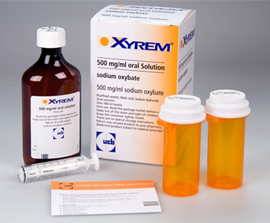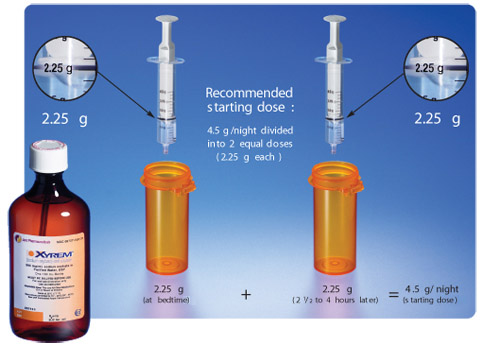By Nancy A. Melville
Medscape Medical News

October 27, 2009 (Phoenix, Arizona) — Sodium oxybate (Xyrem, Jazz Pharmaceuticals Inc.), a novel sleep medication approved by the US Food and Drug Administration (FDA) for the treatment of narcolepsy and cataplexy, offers safe and significant reduction of pain and fatigue in patients with fibromyalgia, according to a study presented here at the American Association of Pain Management 20th annual clinical meeting.
Sodium oxybate, the sodium salt of gamma-hydroxybutyrate, a metabolite of gamma-aminobutyric acid (GABA), is used specifically for the treatment of deep sleep pattern disturbances, and because studies have shown that fibromyalgia patients commonly have deep sleep disturbances, scientists suspected that the drug could help treat the condition's symptoms.
Previous proof-of-concept studies offered evidence that sodium oxybate can reduce pain and fatigue and provide polysomnographic improvements in sleep in patients with fibromyalgia, compared with placebo.
The current phase 3 randomized double-blind study evaluated the treatment in 548 patients with the condition.
The patients were assigned to receive sodium oxybate 4.5 g/night, sodium oxybate 6.0 g/night, or placebo in divided doses at bedtime and 2.5 to 4 hours later, over the course of 14 weeks.
The 334 patients completing the study reproted reductions in pain as early as the first week of the study. The percentage of patients in the sodium oxybate 4.5 g and 6.0 g groups reporting reductions in pain of 30% or more were significantly higher than that in the placebo group (54.2% and 58.5% vs 35.2% respectively; P< .001).
Those reporting pain reductions of 50% or more were also higher in the sodium oxybate groups than in the placebo group (44.7% and 43.3% vs 22.7%, respectively; P < .001).
Mean fatigue scores were significantly reduced in the sodium oxybate 4.5 g and 6.0 g groups, compared with the placebo group, throughout the study, beginning in week 1 (P < .01) and at the study's end point (–27.94 and –30.02 vs –17.57, respectively; P < .001).
The percentage of patients reporting global impression of change scores of "much better" or "very much better" were also significantly higher in the sodium oxybate 4.5 g and 6.0 g groups than in the placebo group (48.3% and 45.4% vs 27.2%, respectively; P < .001) at the study's end point.
The most common adverse events were headache (15% in the 4.5 g group; 23% in the 6.0 g group), nausea (14% in the 4.5 g group; 21% in the 6.0 g group), and dizziness (13% in the 4.5 g group; 17% in the 6.0 g group).
With mechanisms that aren't directly related to sleep, the 3 drugs that are currently approved in the United States for the treatment of fibromyalgia — pregabalin, duloxetine, and milnacipran — might fall short in addressing a hallmark of the condition, said Victor Rosenfeld, MD, a principle investigator on the study and a neurologist at the Samsun Clinic in Santa Barbara, California.
"Surveys of fibromyalgia patients, in fact, show pain to be the fourth most common complaint," he said. "Sleep problems, fatigue, and cognitive dysfunction are actually more prominent complaints in this population, so we know that fibromyalgia is much more than a pain disorder."
The study underscores how the treatment of sleep problems, with a mechanism that isn't currently understood, can help reduce pain, he said.
"Not only do the studies show that sodium oxybate treatment improves patients' sleep and fatigue complaints, interestingly enough, there's a very significant improvement in their pain," he said.
"The data look stronger in terms of pain reduction with this sleep drug than it does with the other FDA-approved medications for fibromyalgia at this time," he said.
Daniel J. Clauw, MD, professor of medicine in the Division of Rheumatology at the University of Michigan, Ann Arbor, said he felt that sodium oxybate represents an exciting new approach to fibromyalgia, addressing an important part of the brain that is not targeted by other therapies.
"This uniqueness of this drug is probably not simply that it is working in part by improving sleep, because other drugs, such as tricyclics and gabapentin/pregabalin, are also likely working in part by improving sleep," he said. "The more exciting property is that this drug is likely working by elevating GABA levels, and that makes it somewhat unique because none of the other drugs that are approved or commonly used for fibromyalgia are likely to be primarily working on this neurotransmitter, which is one of the key inhibitory neurotransmitters in the brain."
An advantage of the drug is that it appears to have a lower risk for nausea as an adverse effect than duloxetine, but a drawback is that, as a potent central nervous system depressant, sodium oxybate comes with a high risk for abuse. But Dr. Clauw said that, in a managed setting, it should gain acceptance as a useful modality in the treatment of fibromyalgia.
"I think that it will be helpful to have this drug approved for use in fibromyalgia," he said. "Most physicians, myself included, will not likely prescribe it initially because of it being a tightly controlled substance, but it is already being prescribed by sleep physicians for narcolepsy, and these same physicians will likely be very comfortable prescribing it for fibromyalgia. So initially, it will likely be used for refractory cases of fibromyalgia."
The study received funding from Jazz Pharmaceuticals Inc. Dr. Rosenfeld reports receiving research support from Jazz Pharmaceuticals Inc. Dr. Clauw reports being a consultant for multiple pharmaceutical companies working in fibromyalgia.
American Association of Pain Management (AAPM) 20th annual clinical meeting: Poster abstract 20. Presented October 9, 2009.
Sodium oxybate(商品名Xyrem,Jazz Pharmaceuticals Inc.公司)是一種新型的安眠藥,美國食品藥物管理局(FDA))核准用於治療猝睡症與猝倒症,根據發表於美國疼痛處置協會第20屆臨床會議的研究,可以顯著減少纖維肌痛病患的疼痛與疲累。
Sodium oxybate是γ-氨基丁酸(GABA)的代謝物、γ-羥基丁酸的鈉鹽,特別用來治療深眠型障礙,另外,因為有研究顯示,纖維肌痛病患一般有深眠障礙,科學家推測此藥物可能有助於治療此狀況的症狀。
以前的概念驗證研究提供的證據認為,相較於安慰劑,sodium oxybate可以減少疼痛和疲累,也可使纖維肌痛病患睡眠時的多頻生理檢查偵測有所改善。
目前的第3期隨機雙盲研究則評估對548名有此狀況之病患的治療。
病患被指派接受每晚4.5 g sodium oxybate、每晚6.0 g sodium oxybate或安慰劑,給藥時間為就寢時與之後2.5至4小時,整個療程為14週。
完成研究的334名病患報告指出,在研究的第一週疼痛就有減少。使用4.5 g sodium oxybate和6.0 g sodium oxybate的病患,疼痛減少30%以上者比安慰劑組多(分別是54.2%與58.5%,安慰劑組為35.2%;P< .001)。
使用sodium oxybate者中,報告疼痛減少50%以上者也比安慰劑組多(分別是44.7%與43.3%,安慰劑組為22.7%;P小於 .001)。
整個研究期間,相較於安慰劑組,4.5 g sodium oxybate組和6.0 g sodium oxybate組的平均疲累分數也顯著降低,研究開始的第一週的P值小於0.01,研究結束時,分別是–27.94 與 –30.02,安慰劑組為–17.57;P小於.001。
研究結束時,相較於安慰劑組,4.5 g sodium oxybate組和6.0 g sodium oxybate組報告指出整體評估分數變化為「不錯」或「好很多」的百分比也顯著較多(分別是48.3%與45.4% ,安慰劑組為27.2%;P小於.001)。
最常見的副作用是頭痛(4.5 g組有15%;6.0 g組有23%)、噁心(4.5 g組有14%;6.0 g組有21%),以及頭昏眼花(4.5 g組有13%;6.0 g組有17%)。
主要研究者、加州Santa Barbara、Samsun診所的神經科專家Victor Rosenfeld醫師表示,機轉和睡眠沒有直接關聯,美國目前核准的三種纖維肌痛藥物— pregabalin、duloxetine與milnacipran —可能不符合此狀況的特徵。
他表示,事實上,纖維肌痛病患的調查顯示,疼痛是最常發生的抱怨的第4名。睡眠問題、疲累、認知功能不佳是此類病患最主要的抱怨,所以我們知道,纖維肌痛不只有疼痛問題而已。
這項研究強調的是如何治療睡眠問題,藉由目前尚不清楚的機轉而有助於減少疼痛。
他表示,該研究不只顯示sodium oxybate治療可改善病患的睡眠和疲累,更有趣的是,他們的疼痛也有相當程度的改善。
他表示,就減少疼痛的資料看來,這個安眠藥物的止痛效果優於目前其他FDA核准的纖維肌痛藥物。
密西根大學風濕科醫學教授Daniel J. Clauw醫師表示,他認為sodium oxybate代表一個令人振奮的纖維肌痛新療法,提出其他治療方法未著眼的、有關於腦部的重要部份。
他表示,這獨一無二的藥物或許不只因為改善睡眠,因為其他藥物,如三環抗憂鬱藥和gabapentin/pregabalin,作用也是改善睡眠。更令人振奮的性質是,此藥可能可以提高GABA值,使它因而有獨特性,因為其他已經核准或習於用來治療纖維肌痛的藥物,都沒有這個作用於神經傳導物質的性質,而這個物質是腦中關鍵的抑制型神經傳導物之一。
這個藥物的優點之一是,噁心這個副作用的風險比duloxetine少,但缺點是,因為sodium oxybate是一個強力中樞神經系統抑制劑,可能會有濫用風險。但是Clauw醫師表示,就處置而言,可接受它為治療纖維肌痛的有用方法。
他表示,我認為,這有助於此藥獲得核准用於纖維肌痛。多數醫師、包括我自己,一開始可能不會處方它, 因為它是受嚴格管制的物質,不過它已經被睡眠症醫師處方用於治療猝睡症,這些醫師也可能樂於用它來治療纖維肌痛,所以,它可以先用來治療難治型的纖維肌痛。
本研究接受Jazz Pharmaceuticals Inc.公司的資金。Rosenfeld醫師報告接受Jazz Pharmaceuticals Inc.公司的研究支持。Clauw醫師報告擔任多家研究纖維肌痛的藥廠的顧問。





 留言列表
留言列表
 線上藥物查詢
線上藥物查詢 